
For a long, long time my roasted potatoes were okay, but nothing to write home about. I wanted a crispy exterior and an creamy interior but it seems I was always sacrificing one to obtain the other. If the outsides were crispy the insides were undercooked. When the insides were just how I wanted them the outsides had moved from crispy to crunchy–a world of difference when you’re talking about potatoes. My world was crashing in around me. Then everything changed.
A couple of years ago when my wife and I got really into playing darts we discovered a simple, seemingly obvious and game-changing truth: the game of darts gets a lot easier when you know what you’re aiming at. Rather than randomly chucking darts at the board we started to refine our focus, we started to develop strategies about what numbers to throw at and when. After time and practice we were able to hit our target more often than not. Similarly, cooking potatoes got much easier when I thought about what I was aiming at. Creamy. Crispy. Chunky. Firm. Because potatoes are made up primarily of two things—moisture and starch—we must manipulate the balance between the two to hit our po-target. Today, the target is roasted potatoes.
What is the target?
When I think of perfect roasted potatoes I think of golden-brown, light, crispy, outsides. Tons of flavors hidden in the little nooks and crannys of each bite. Every time you stab one with your fork it issues a wonderful crackling sound. The inside is smooth and almost creamy. You almost don’t have to chew it. You can just kind of press it to the roof of your mouth with your tongue and it melts away. Having that image in my head, I’ve established my target. That’s what I’m aiming at.
Choosing the right potato

Obviously you can roast any potato. I mean, you can roast just about anything. I can roast a raincoat if I choose. But the potato that “wants” to be crispy on the outside with a smooth creamy interior, from my experience and experiments, is the Yukon gold. More generally, a medium starch potato. (The second best option is a high starch variety; low starch potatoes come in third.) The medium starch potato has enough starch to soften up and give you a creamy center but not so much starch that it completely loses its shape and falls apart.
Getting two textures in one potato
I want the outside crispy and the inside creamy. There are two textures that I’m going for simultaneously so it makes sense that I’ll need to use two different cooking methods: a moist heat cooking method for the creamy inside and a dry heat cooking method for the crispy exterior. In this case we will be boiling and roasting. We need to manipulate the balance of starch and water somehow. The first thing we did to control the starch level was select the right potato. The next way involves the moist heat cooking method: boiling.
Boiling the potatoes
Our roasted potatoes start off in some water. After cutting the potatoes into large bite-sized cubes, they need to be boiled. The point of boiling is to get the inside of the potato smooth while at the same time preparing the outside for crisping later on. Typically, potatoes go into a pot of water to cook them evenly throughout. But we don’t want these to be evenly cooked. That means doing things differently, namely changing the environment they are boiled in.

Changing the environment: The ph level
The first way I’m going to change the environment is by adding baking soda to the water. That’s going to create an alkaline environment for the potatoes to boil in. The starch in the potato will react by getting soft giving them a fuzzy or furry look after boiling. The little ridges and bumps and peaks and valleys on the potatoes’ exterior give them a fuzzy/furry look. That’s exactly what we’re looking for. The uneven “landscape” means more surface area. Think about forty square miles in Colorado versus the same amount of land in Kansas; if you pulled the land out flat like a sheet, the Colorado sheet would be a lot bigger than the Kansas sheet. The Rocky Mountains have much more surface than the open, primarily flat farmlands of Kansas.
For maximum crispiness to develop we need as much surface area as possible exposed to the heat when roasting. Having more surface area also more means there are more escape routes for the steam to exit the potato once removed from the water. (Those escape routes are important. The reason will be clear in just a bit.)
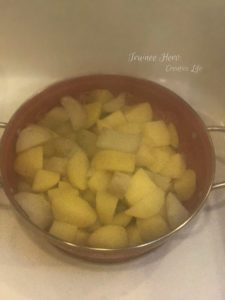
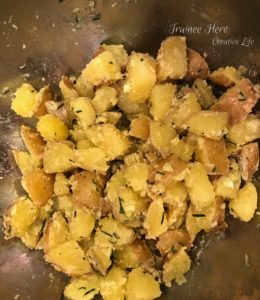
Changing the environment: The timing
The second change to the environment relates to timing. Typically, you put potatoes into a pot of cold water and then bring the water to a boil. For these roasted potatoes, we want the water at a full rolling boil before adding the potatoes. Since we want their outsides to have a different texture than their insides, we don’t want them to cook evenly. Waiting until the water is boiling to begin cooking the potatoes causes the outside to soften up much faster than the inside. (Interestingly, it’s the softness of the outside that will become crispy and the relative firmness of the middle that will become creamy). I’m going to offer some general timing guidelines but you really can’t beat the eye test. When the outside of the potatoes look fuzzy or furry pull one out and pierce it with the tip of a paring knife. The knife should slide in easily and meet resistance towards the center.
Getting them ready for the oven
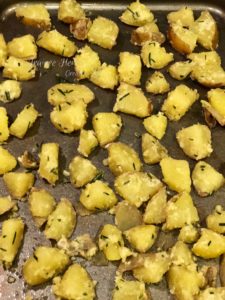
Next we’ll focus on the moisture in the potatoes. Once you empty the potatoes into a colander, let as much of the steam leave the potatoes as possible. Steam is moisture and we want it gone. Too much moisture left in the potatoes prevents them from roasting once in the oven. Instead the moisture will steam the potatoes in the oven. Roasted potatoes with a crispy outer layer require exposing the surface of the potatoes to a dry heat. I’ve yet to encounter a crispy steamed potato.
Remember those escape routes I mentioned earlier? This is why they’re so important—those bumps and ridges give the steam more ways to get out and make it possible to get a boiled potato crispy. When the potatoes have pretty much stopped steaming, transfer them from the colander to a large mixing bowl. For goodness sake, don’t worry about being gentle with them; you want to rough them up a bit; it will give them even more exposed surface area. Add the olive oil, corn starch, and seasonings and mix them together using a spatula.
Getting them in the oven
Place the evenly coated potatoes on the baking sheet. Two things: 1. Make certain to leave space between each piece of potato to allow heat access to all parts of the surface area, and 2. Ideally have all the pieces uniformly facing either skin side up or skin side down. When it comes time to flip the potatoes you’ll know which have been flipped and which haven’t. At this point we are nearly done.
Place the baking sheet in the oven. If you’re the type who likes to watch things cook and constantly check to see how it’s going, use the oven light. Do your best to keep the oven door shut. Roasted potatoes need consistent heat. After the potatoes have been in the oven for about 30-35 minutes, remove the baking sheet and carefully flip the potatoes. The side that had been facing down should be a nice golden color while the side facing up will still look as though it needs more cooking.
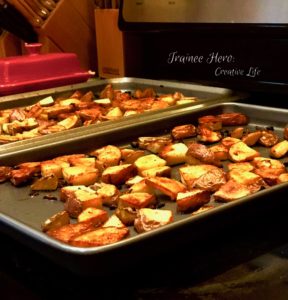
Before carefully flipping the potatoes, I generally like to drizzle more olive oil on them. Once flipped you can return them to the oven and allow them to finish roasting. They will be good. I promise.
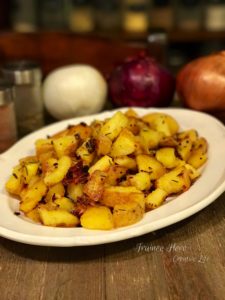
| Prep Time | 20 minutes |
| Cook Time | 45 minutes |
| Servings |
people
|
- 4 lbs Yukon gold potatoes
- 3/4 Tbs baking soda
- 3 sprigs Rosemary Finely chopped. Adjust to taste. We like a lot of Rosemary
- 4 cloves garlic Minced. Adjust to taste. We like a lot of garlic.
- 5 Tbs olive oil Separated.
- 1 Tbs corn starch
Ingredients
|
|
- In a large pot, add baking soda to 10 cups of water and bring to a boil. Preheat oven to 425 degrees.

- While water comes to a boil, cut potatoes into bite-sized pieces, chop and mince rosemary and garlic.
- Add potatoes to boiling water and boil for approximately 10 minutes. The outside of the potatoes should fuzzy/furry while the insides are still firm. Insert a paring knife into a potato to check for firmness.
- Empty the contents of the pot into a colander and allow potatoes to cool for five to ten minutes. Allow as much steam to leave the potatoes as possible.

- In a large mixing bowl, combine potatoes, olive oil, corn starch, rosemary, garlic, salt, and pepper.
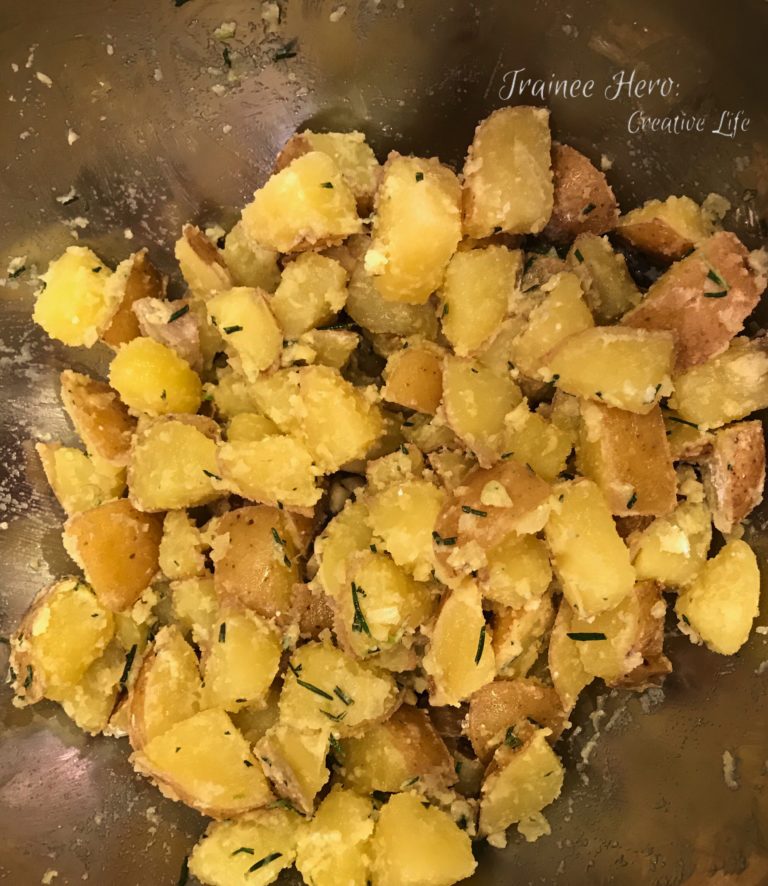
- Place potatoes onto baking sheet(s) making sure to keep potatoes from touching and that potatoes are either uniformly skin-side up or skin-side down.

- Place baking sheets into the oven for approximately 20 minutes. Remove potatoes from oven and flip them. Add remaining olive oil. Return to oven.
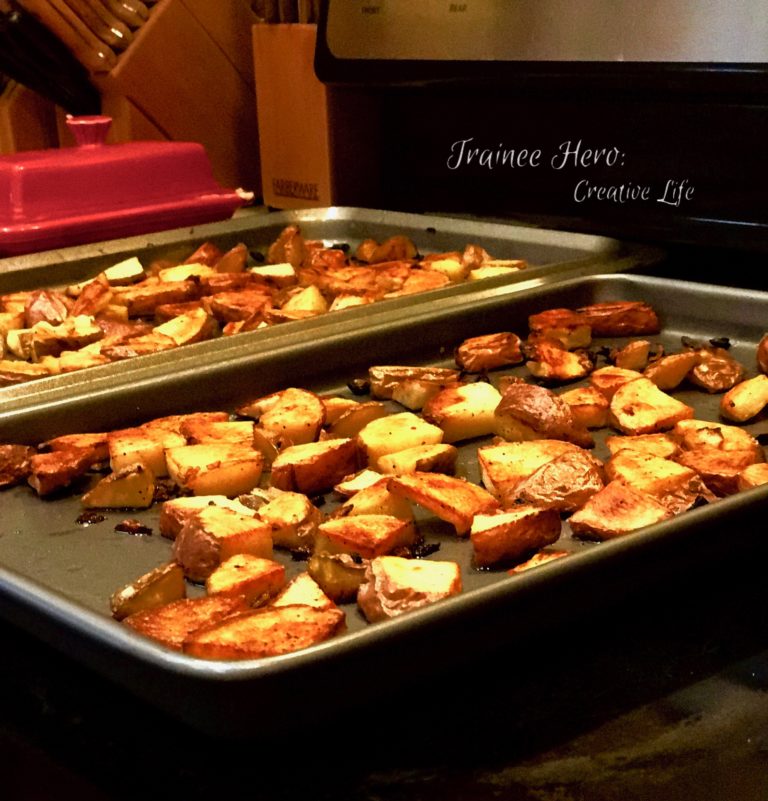
- Cook for an additional 20-25 minutes. Remove from oven. Salt and pepper to taste. Serve immediately.


My spouse and i got quite glad that John could deal with his preliminary research through the ideas he grabbed out of your web page. It’s not at all simplistic to just continually be giving out methods that many others have been selling. And we also fully understand we have got the website owner to be grateful to for that. The main explanations you have made, the simple site menu, the friendships you can help foster – it’s got many great, and it’s really helping our son and the family imagine that the matter is excellent, and that is pretty indispensable. Thank you for everything!
This is really interesting, You are a very skilled blogger.
I have joined your feed and look forward to seeking more of your great post.
Also, I have shared your website in my social networks!
I wanted to thank you for this fantastic read!! I certainly enjoyed every little bit of it.
I have got you saved as a favorite to check out new things you post…
Nice blog here! Also your web site loads up very fast! What web host are you using?
Can I get your affiliate link to your host? I wish my site loaded up as fast as yours lol
I’m extremely pleased to uncover this great site. I need to
to thank you for your time for this particularly wonderful read!!
I definitely liked every part of it and i also have you book marked to look at
new stuff on your blog.
What’s up, just wanted to say, I enjoyed this article. It was helpful.
Keep on posting!
My programmer is trying to convince me to move to .net from
PHP. I have always disliked the idea because of the costs.
But he’s tryiong none the less. I’ve been using Movable-type on a variety of websites for about a year and am worried about switching to
another platform. I have heard great things about blogengine.net.
Is there a way I can import all my wordpress content into it?
Any kind of help would be greatly appreciated!
I could not refrain from commenting. Exceptionally well written!